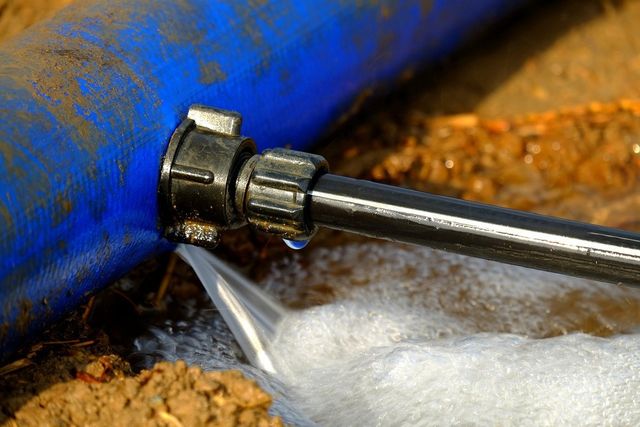Unearthing Concealed Water Line Leaks: Six Proven Techniques
Unearthing Concealed Water Line Leaks: Six Proven Techniques
Blog Article
Everyone may have their own unique theory about Top leak detection hacks.

Early discovery of dripping water lines can alleviate a potential disaster. Some little water leaks might not be visible.
1. Examine the Water Meter
Every home has a water meter. Examining it is a surefire manner in which aids you discover leakages. For starters, turn off all the water sources. Guarantee nobody will flush, use the tap, shower, run the cleaning machine or dishwashing machine. From there, go to the meter as well as watch if it will certainly transform. Given that no one is using it, there ought to be no motions. If it relocates, that indicates a fast-moving leakage. Likewise, if you identify no changes, wait a hr or two and also examine back once more. This indicates you may have a slow leakage that could even be below ground.
2. Check Water Intake
Assess your water bills and track your water consumption. As the one paying it, you ought to discover if there are any type of discrepancies. If you spot sudden changes, in spite of your intake being the same, it indicates that you have leaks in your plumbing system. Remember, your water bill ought to fall under the same array every month. A sudden spike in your expense indicates a fast-moving leakage.
At the same time, a consistent rise every month, despite the very same routines, reveals you have a sluggish leak that's additionally gradually intensifying. Call a plumber to extensively check your residential property, especially if you really feel a cozy location on your floor with piping below.
3. Do a Food Coloring Examination
30% comes from bathrooms when it comes to water consumption. Examination to see if they are running correctly. Decrease flecks of food shade in the tank as well as wait 10 minutes. If the shade in some way infiltrates your dish during that time without flushing, there's a leak in between the container and dish.
4. Asses Outside Lines
Do not forget to examine your exterior water lines as well. Test spigots by connecting a yard hose pipe. Ought to water permeate out of the connection, you have a loose rubber gasket. Replace this and also make sure all connections are limited. It will help obtain it professionally checked out as well as kept annually if you've obtained a lawn sprinkler system. One little leak can throw away tons of water as well as surge your water costs.
5. Examine and also Examine the Situation
Homeowners must make it a practice to inspect under the sink counters as well as also inside cupboards for any type of bad odor or mold and mildew development. These two warnings suggest a leak so prompt interest is called for. Doing regular examinations, even bi-annually, can conserve you from a major problem.
Much more significantly, if you understand your house is currently old, maintain a watchful eye on your heating systems, hoses, pipes etc. Check for stainings and damaging as a lot of appliances as well as pipelines have a life span. They will additionally normally deteriorate because of tear and wear. Don't wait for it to rise if you presume leaking water lines in your plumbing system. Call an expert plumber right away so you do not end up with an awful mess in your house.
Early detection of dripping water lines can reduce a possible disaster. Some little water leaks might not be noticeable. Examining it is a proven means that helps you uncover leakages. One tiny leakage can throw away tons of water and increase your water expense.
If you think dripping water lines in your plumbing system, don't wait for it to intensify.
WARNING SIGNS OF WATER LEAKAGE BEHIND THE WALL
PERSISTENT MUSTY ODORS
As water slowly drips from a leaky pipe inside the wall, flooring and sheetrock stay damp and develop an odor similar to wet cardboard. It generates a musty smell that can help you find hidden leaks.
MOLD IN UNUSUAL AREAS
Mold usually grows in wet areas like kitchens, baths and laundry rooms. If you spot the stuff on walls or baseboards in other rooms of the house, it’s a good indicator of undetected water leaks.
STAINS THAT GROW
When mold thrives around a leaky pipe, it sometimes takes hold on the inside surface of the affected wall. A growing stain on otherwise clean sheetrock is often your sign of a hidden plumbing problem.
PEELING OR BUBBLING WALLPAPER / PAINT
This clue is easy to miss in rooms that don’t get much use. When you see wallpaper separating along seams or paint bubbling or flaking off the wall, blame sheetrock that stays wet because of an undetected leak.
BUCKLED CEILINGS AND STAINED FLOORS
If ceilings or floors in bathrooms, kitchens or laundry areas develop structural problems, don’t rule out constant damp inside the walls. Wet sheetrock can affect adjacent framing, flooring and ceilings.
https://www.servicemasterbyzaba.com/blog/how-to-detect-water-leakage-in-walls/

Do you enjoy reading up on Top leak detection hacks? Put feedback down the page. We will be pleased to see your insights about this blog entry. We hope that you come back again in the near future. Make sure you take a moment to promote this page if you enjoyed reading it. Many thanks for going through it.
Start Now Report this page